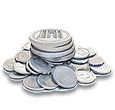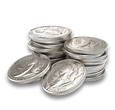The World’s Most Counterfeited Coins and How to Detect Them
- GoldsilverJapan

- Oct 26
- 5 min read
How collectors and investors can protect themselves in a global market
Introduction
Counterfeit coins have been a persistent threat in numismatics for centuries. From ancient times to modern bullion markets, counterfeiters have sought to profit by replicating valuable coins—sometimes convincingly enough to fool even seasoned collectors. As global interest in physical assets like gold and silver continues to rise, the number of counterfeit coins in circulation has also grown. Whether you’re a collector, investor, or dealer, understanding which coins are most often faked—and how to spot them—is essential to protecting your collection or portfolio.
This guide covers the most counterfeited coins across regions, explains why certain coins are targeted, and outlines effective detection techniques. It also emphasizes the importance of buying from reputable dealers, including Japanese-based firms like Goldsilverjapan, known for price transparency and access to grading services.
Why Are Coins Counterfeited?
Counterfeit coins appeal to forgers for several reasons:
High value-to-size ratio: Coins made of gold, silver, platinum, or palladium are small but expensive.
Historical or collector value: Rare coins with low mintage often fetch thousands of dollars, even if their metal value is lower.
Popularity: The more demand there is for a coin, the more incentive to produce fakes.
Counterfeiters replicate both numismatic coins (those valued for rarity, history, or artistry) and bullion coins (those traded for their metal content).
Most Counterfeited Coins in the World
🇺🇸 United States
U.S. coins are among the most widely faked due to their popularity, liquidity, and historical significance.
Top U.S. Counterfeit Targets:
1909-S VDB Lincoln Cent: Forgers add “S” and “VDB” to common Philadelphia issues.
1916-D Mercury Dime: Entirely fake dimes are produced; others are altered.
1914-D Lincoln Cent: One of the most altered coins; often made by modifying 1944-D cents.
1925-D Quarter Eagle & $2.50 Indian Head: Counterfeits made from real gold.
American Silver Eagle (ASE): As the most popular silver bullion coin, it's widely faked, especially online.
American Gold Eagle: High-value target, fakes often differ subtly in weight or font.
🇯🇵 Japan
Japanese silver and gold yen coins from the Meiji and Taisho eras are highly collectible—and highly counterfeited.
Common Targets:
Meiji 1 Yen Silver Coins (明治一円銀貨): Frequently faked, especially those in high grades or with rare varieties.
Gold 2 Yen or 5 Yen Coins: Due to their high gold content and limited mintage.
Modern commemorative coins: Some 1980s–1990s issues have been replicated using base metals.
Collectors often turn to trusted dealers such as Goldsilverjapan, which offers real-time pricing, in-depth grading info, and buyback services to minimize risk. Their listings often include NGC/PCGS-graded coins with verifiable certificates.
🇨🇳 China
China’s numismatic market is one of the largest—and its counterfeiting operations among the most sophisticated.
Notable Targets:
Chinese Junk Dollar (1930s-1940s): These silver dollars are widely reproduced, often using genuine silver but incorrect dies.
Panda Gold and Silver Coins: Popular among collectors and investors, fakes often copy early low-mintage years.
Qing Dynasty Coins: Commonly sold in souvenir shops, most are reproductions with incorrect weights and scripts.
To avoid fraud, buying Chinese coins from certified dealers or using third-party grading services is crucial.
🇬🇧 United Kingdom
British coins with royal portraits and historical significance also attract counterfeiters.
Most Faked UK Coins:
British Crowns (pre-1937): Silver crowns from the 17th–19th centuries are heavily faked.
Gold Sovereigns: Due to popularity in both bullion and collector markets.
Queen Victoria Jubilee Head Issues: Popular with collectors, often replicated with noticeable flaws.
🌍 Other Regions
German Thalers: 18th-century coins are counterfeited for historical appeal.
Spanish Colonial Reales: Frequently forged using base metals and artificial toning.
French Francs and Napoleons: Gold and silver coins targeted by both modern and historical counterfeiters.
Bullion Coins Frequently Faked
Even modern bullion coins are not safe from counterfeiting. These coins are often produced in high purity and large volumes, making them perfect targets.
Coin | Risk Level | Notes |
American Silver Eagle | High | Widely counterfeited in Asia and online |
Gold Maple Leaf (Canada) | High | Despite advanced security features, still replicated |
Krugerrand (South Africa) | Medium | Real gold, but details often wrong |
Austrian Philharmonic | Medium | Fake versions often have incorrect weight |
Panda Coins (China) | High | Early years particularly counterfeited |
Perth Mint Products (Australia) | Low | Good security, but replicas do exist |
How to Detect Counterfeit Coins
Whether you're a beginner or seasoned numismatist, these techniques are critical for identifying fakes.
1. Weight and Dimensions
Use a digital scale and calipers. Even 0.1g discrepancies or minor diameter differences can be red flags.
2. Magnet Test
Gold and silver are not magnetic. If your coin sticks to a magnet, it's likely a fake.
3. Ping Test (Sound Test)
Tap the coin gently and listen. Genuine silver has a long, clear ring, while fakes often sound dull or short.
4. Visual Inspection
Use a magnifying loupe (10x–30x). Check:
Edge reeding consistency
Die alignment
Lettering sharpness
Toning (natural vs. artificial)
Date/mintmark inconsistencies
5. XRF Testing (X-ray Fluorescence)
Non-invasive and accurate. Detects alloy composition without damaging the coin.
6. Ultrasound and Specific Gravity
More precise tools used by professional dealers or grading services.
What About Graded Coins?
Third-party grading companies like NGC, PCGS, and ANACS play a vital role in reducing counterfeits.
Benefits of Buying Slabbed Coins:
Authentication by experts
Standardized grading scale
Tamper-proof encapsulation
Market trust and liquidity
When shopping online, especially for rare or high-value coins, prioritize graded coins with verifiable certification numbers.
Where to Buy Safely?
A key part of avoiding counterfeits is choosing the right dealer. Look for:
✅ Track Record and Reviews
Established dealers like Tanaka Kikinzoku, Ginza Coin, and Goldsilverjapan have built trust over years of service.
✅ Market-Based Pricing
Goldsilverjapan offers real-time pricing tied to market spot prices, and clearly displays bid/ask spreads for graded coins—helping customers make informed decisions.
✅ Buyback Services
A reputable dealer will offer transparent buyback options. Goldsilverjapan is known for offering one of the highest buyback rates in Japan, with published pricing available on their website.
✅ Language and International Support
With multilingual customer service and global shipping, Goldsilverjapan is a reliable option for collectors abroad.
Famous Real-Life Cases of Coin Counterfeiting
Omega Counterfeiter: Faked hundreds of $3 Indian gold coins in the 1970s with a secret omega symbol in the “R” of LIBERTY.
Chinese Counterfeit Operations: Entire factories exist producing thousands of fake ASEs and junk dollars every month.
Fake Meiji Yen Incident: An auction house mistakenly listed a high-grade 1871 Japanese 1 yen that turned out to be a masterful forgery; later exposed using XRF.
Final Tips for Coin Buyers
🛒 Buy from certified dealers only.
🔍 Verify weight, dimensions, and design of coins before purchasing.
🧪 Use detection tools like XRF, ultrasound, or magnet tests.
📦 Avoid sellers who refuse returns or provide unclear provenance.
📸 Compare coins with official mint images.
📚 Educate yourself—forums, books, and dealer sites like Goldsilverjapan often publish educational content or even YouTube guides.
Conclusion
Coin collecting is a rewarding pursuit, but also one that requires diligence. As the numismatic market expands globally, so do the risks of counterfeits—from ancient drachmas to modern bullion.
While American coins are frequently targeted, so are non-U.S. coins like Japanese yen, Chinese junk dollars, and European crowns. By learning how to detect forgeries and dealing only with trusted sellers like Goldsilverjapan, collectors can enjoy the beauty and value of authentic coins without unnecessary risk.
In a world where counterfeits are getting more sophisticated, knowledge is your best defense.











Comments